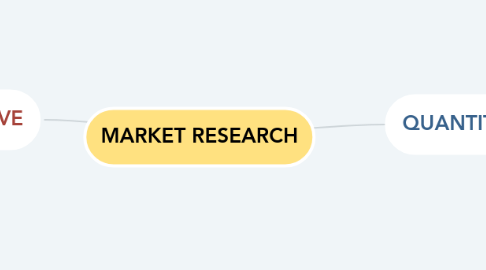
1. QUANTITATIVE
1.1. DEFINITION: Research involving the administration of a set of structured questions with predetermined response options to a large number of respondents.
1.2. BENEFITS: Data format and sources are clear and well defined, and the compilation and formatting of the data gathered follow an orderly procedure that is largely numerical in nature.
1.3. LIMITATIONS: Does not give rich insight into understanding human behavior.
1.4. TYPES
1.4.1. OMNIBUS
1.4.1.1. DEFINITION: A syndicated study serving several purposes at any given time. conducting a number of interviews with a specific target group on a regular basis. The survey is conducted on behalf of a number of different organisations, who each pay to join the survey, and add their own questions.
1.4.1.2. BENEFITS: -Serves several purposes at a given time -Compromising several items/categories -Run regularly (weekly/monthly/quarterly) -Fast turnaround time -Can accommodate large sample sizes -Cheaper than Ad Hoc
1.4.1.3. LIMITATIONS: -Sample is open and unspecific -Requires many respondents so that it may be full representative -Need to cover many locations
1.4.2. PRODUCT TESTING
1.4.2.1. DEFINITION: - Methodology to collect both qualitative and quantitative information about consumers potential consumption/usage behavior, preferences, and reactions on a product
1.4.2.2. BENEFITS: - Can test different underlying marketing needs through Innovation, Renovation, and Benchmarking.
1.4.2.3. LIMITATIONS: - CLT can pressure its respondents since it is conducted in a stimulus environment
1.4.2.4. CLASSIFICATIONS
1.4.2.4.1. 1. INNOVATION To test a product that has not be launched
1.4.2.4.2. 2. RENNOVATION improve a product that is existing , or choosing the best from all the product lines you have
1.4.2.4.3. 3. BENCHMARKING to compare vs the competitors , brand vs brand
1.4.2.5. KEY CONSIDERATIONS:
1.4.2.5.1. 1.Central location test (CLT) -it is in a controlled environment In-home usage test (HUT) -asked to use the product in natural/ realistic environment
1.4.2.5.2. 2. Blind - early stages, new formulation , absence of brand and positioning, new product , unbranded bec the focus is on the product itself , no bias to branding, positioning, reputation or brand equity Identified - Brand is shown = use when your brand or product is not in the early stages; for benchmarking
1.4.3. USAGE AND ATTITUDE
1.4.3.1. DEFINITION: - Measure usage and attitude of products and services Determine penetration/incidence of product/service usage
1.4.3.2. BENEFITS: - Define gaps and opportunities - Covers 5Ps of Marketing
1.4.3.2.1. 5 p's of marketing and U&A
1.4.3.3. LIMITATIONS: - Perceptions and behavior may vary
1.4.4. ADVERTISING TESTING
1.4.4.1. DEFINITION: - Evaluate concepts (product or advertising) before they are put in production - Gauge consumer reaction Spots for areas to improve on
1.4.4.2. BENEFITS: - Test each advertising communication concept with target audience to understand elements that are working and those that aren't - Help understand whether advertising is on or off strategy
1.4.4.3. LIMITATIONS: - Unable to understanding emotional drivers - Unable to understanding why respondents like what they like - Understanding other market nuances which influence respondents - Being tested in an artificial situation
1.4.5. TRACKING
1.4.5.1. DEFINITION: - Continous study that monitor all changes in the market
1.4.5.2. BENEFITS: - Has specific measures such as Ad Execution, Awareness, Usage, etc.
1.4.5.3. LIMITATIONS: - It is a continuous study, clients won't get their results immediately as tracking takes months or sometimes years
1.4.5.4. TYPES
1.4.5.4.1. CONTINUOUS done in an extended period, done regularly TO monitor changes in the market like market share, behavior of consumers, perceptions, market sales AD HOC - specific issue or problem , done in a shorter period , tailor fit
1.4.5.4.2. Aspects Marketers have no control over: :weather, distribution, global economics, social stability, competitor activities, negative PR, retail display, seasons etc.
2. QUALITATIVE
2.1. DEFINITION: Free willing discussion to understand the emotive drivers of a person rather than just the rational explanations
2.2. BENEFITS:
2.3. LIMITATIONS:
2.4. TYPES
2.4.1. FOCUS GROUP DISCUSSION
2.4.1.1. DEFINITION: Done in small groups of people to gather information on a certain area of interest that is led by a moderator who is usually also the researcher
2.4.1.2. BENEFITS: - Understands consumer language - Generates New Ideas - Unravels consumer deeper motivations, perceptions, and attitudes
2.4.1.3. LIMITATIONS: Limitations: - Answers can be influenced by other participants of the group - Peer pressure from other participants - Subjective answers are unquantifiable - Cannot be utilized for sensitive topics - The facilitator plays a big role in the entire interview process thus affecting its success
2.4.2. OBSERVATION/ETHNOGRAPHY
2.4.2.1. DEFINITION: Composed of different techniques involving people or topics of interest documented by observing
2.4.2.2. BENEFITS: - There is stimulus from the environment - Real time and first hand experience - Cultural understanding
2.4.2.3. LIMITATIONS: - Logistically hard to plan - Hard to analyze the results - Cannot replicate actual experience because participants are conscious
2.4.3. INDEPTH INTERVIEWS
2.4.3.1. DEFINITION: A one-on-one interview designed to probe respondents in order to grasp a deeper insight in terms of behavior
2.4.3.2. BENEFITS: - Allows the respondents to be more open - More flexible in schedules - Unveils deeper insights from each respondent - Eliminates the influence of other respondents - Reaches rural areas
2.4.3.3. LIMITATIONS: - Time consuming in gathering enough data and respondents - Free flowing of ideas from an IDI can allow unrelated responses
